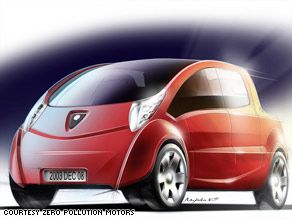The idea of an air-powered car may remind of you that Simpsons episode featuring Ed Begley, Jr. and his car, which is “powered by [his] own sense of self-satisfaction,” but it’s a real idea. Modern gasoline and diesel engines use the force of combustion to push the pistons downward and generate power. Similarly, air-powered engines feed bursts of highly compressed air into the engine to force the piston downward and create forward momentum.
It works, but is it practical?
Yes! Or, at least, possibly. As with many of these emerging technologies there are both upsides and downsides compared to existing petroleum based cars. Surely not an exhaustive list, but here are some of those issues.
Pro
- Air can be compressed using power from the grid, which has cleaner emissions than normal cars and can come from renewable energy sources.
- Air cars could be filled up at home or on the road. Unlike electric cars, air cars could fill up more quickly and therefore get the necessary range boosts for long trips.
- Air cars can be hybrids, just like gasoline vehicles, for range-extension.
Con
- There are still a lot of questions about the safety of carrying around large amounts of highly compressed air.
- Unlike electric cars, air cars still have a lot of moving parts that could fail.
- They are untested on the large scale
Coming in 2010: 106-mpg, $18,000 air car
That’s if you believe the claims of the inventors, MDI. MDI is a European company that has been working with the concept of air-powered vehicles since it was founded in 1991. Though they won’t be bringing the car Stateside themselves, they’re working with a NY-based company called Zero Pollution Motors to do so.
The first thing you’ll notice is the “106-mpg” figured. Since it doesn’t use gas, how can it have a “miles per gallon” figure tagged on with it? Well, as ZPM explains, that is really an mpg-equivalent figure used to compare the air car’s efficiency to gasoline-powered vehicles:
If you can, imagine a vehicle that runs on air, achieves over 100 gas-equivalent mpg and over 90 mph, has zero to low C02 emissions, seats six, has plenty of space for luggage, cuts no safety corners, and costs no more than an average economy to mid-size vehicle.
106 is definitely a high number, and as ZPM points out, is much higher than any car on the US market at the moment. I don’t know if I believe it, but I know that number is easily in reach for many electric cars, so I don’t see why it would be impossible in this case. Once the car hits the market, however, I’m sure will hear a lot more about the claimed efficiency ratings.
Similarly, you can check out the price tag here. ZPM states that using sales techniques like direct marketing, they can drive the starting-cost down to $17,800, which is a pretty good deal when you consider that it’s cheaper than any hybrid on the market.
The car will feature a 75hp engine, which allows it to reach speeds of 90 mph and have a range of up to 800 miles on any given “fill.” Though the car will be a bit more complex to operate than an EV, it will only need oil changes every 30k miles and can cost as little as $2 in electricity to fill up the air tank.
I’ll be excited to see how it does in the upcoming X-Prize competition. For now, you can find out more details at the ZPM site.
If you liked this post, sign up for out RSS Feed for automatic updates.
Popularity: 3% [?]





{ 10 comments }
I’m a volunteer firefighter and we carry a lot of compressed air around with us all the time – no safety concerns…. other than the cylinder exploding and ripping you apart 🙂 Only joking, the temps required for that are pretty hot.
if it’s 0 apr, i’m sold.
Although compressed air is considered dangerous, with the new hyroforming technology (5000psi) combining frame rail/chassis/hydroforming and compressed air tanks in one would do well to ameliorate this fear…no tanks!
It won’t have much of a heater, but A/C should be no problem.
Seriously, how do you heat the cabin? In the south this might be ok, but in winter this car would freeze you to death.
Heating a alternate-fuel vehicle will always be a problem. Combustion engines give a lot of waste heat off, but EVs don’t. Maybe you’ll need a propane tank?
Air compressors are highly inefficient, as well as air motors, why take the extra steps between electricity production and power to the road, just use an EV in the first place.
Late in the day to this discussion, but the simple reason for using air is full up time. In theory all a current gas station would need is a high pressure compressor installed and then you can simply drive in, fill up with compressed air in minutes, and drive out (well maybe pay for the cost of the electricity).
With an Ev, you simply drive in, plug it in for 4-6 hours and then drive out.
Is the 800 mile range a misprint or is there a really humongous trailer with a giant air tank on it?
I hope they will eventually come to market, cause it seems like everybody is concentrated on making electric cars
I just want to bring this topic to the front for anyone subscribed… It’s almost 2010, and we’ll see soon if this had any substance, or if it was merely a marketing stunt a’la HP2g.
Comments on this entry are closed.